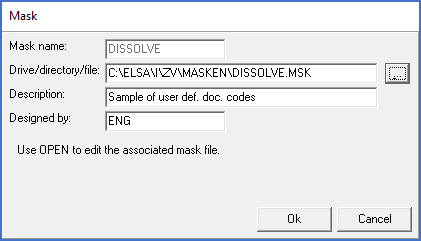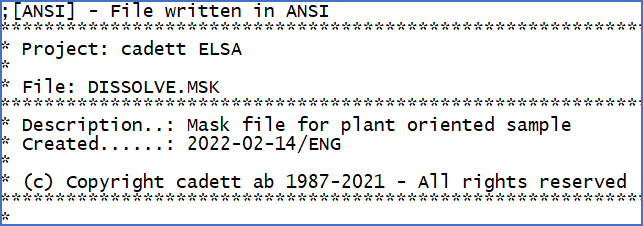|
<< Click to Display Table of Contents >> Title field links |
  
|
|
<< Click to Display Table of Contents >> Title field links |
  
|
The drawing frame that is used for the example is the standard ELSA390E.DXF. No changes are needed to handle the example, even-though several additional document codes are added. The DC block in the ELSA390E.DXF drawing frame, is equipped with no less than 10 attributes for document code storage. As long as you do not need more than so, no changes are needed.
The mask file for the sample (DISSOLVE.MSK), is based on the ELSA390 standard mask file, but it has been customised with several additions and changes.
Those changes and additions are discussed below, one by one.

Figure 585: A mask named "DISSOLVE" refers to a mask file named "DISSOLVE.MSK" in the example.
The header in the DISSOLVE.MSK is of course updated with name and date, as shown in the figure below.

Figure 586: When you create new mask files, or adjust old ones, please do not forget to update the header in them.
The length of the file names has been increased to 19 characters, which makes it necessary to move the description and the time to the right, in order to avoid a conflict between the longer filename and the fields to the right of it in the detailed view. That is shown in the figure below.

Figure 587: The file name is prolonged, which makes it necessary to adjust other fields as well.
The default values for titles 1, 2 and 3 have been adjusted. Title line 2 and 3 will get their values from unity description 1 and 2 in the project parameters, instead of 2 and 3 in the ELSA390. Title line 1 will get its value from the last document code that is selected, which will be the DCC code, meaning the document kind, like circuit diagram or similar. The figure below shows the default value specification for these fields in the mask file.

Figure 588: The !LASTZ variable gets the description text from the right-most specified document code in the file name composition
Four fields have been added to accommodate the four levels of the function/plant document code tree. These added fields are names ZDC6, ZDC7, ZDC8 and ZDC9, for reasons that will be obvious further down. The figure below shows the four new DC fields, below the four that already exist in ELSA390.

Figure 589: The definitions of four added DC fields named ZDC6 - ZDC9
The default values for the four new DC fields are shown in the figure below. They are connected to file name segments number 6, 7, 8 and 9. You will find an explanation of that further down in this description.
The same figure also shows the link to the DC block in the title field. The DC block is hidden.

Figure 590: Default values and title field links for ZDC6 - ZDC9
The table below shows all relevant information in the mask file for the four added DC fields ZDC6 - ZDC9.
Field name |
Length |
YK |
XK |
Type |
Decimals |
View |
Prompt |
Function code |
Tooltip |
Default |
Block |
Tag |
Language |
|---|---|---|---|---|---|---|---|---|---|---|---|---|---|
ZDC6 |
3 |
1 |
1 |
X |
0 |
0 |
Function/plant level 1: # |
1202 |
Entered automatically |
!SHORTDESC:DFNSEG=6 |
DC |
ZDC6 |
GB |
ZDC7 |
3 |
1 |
1 |
X |
0 |
0 |
Function/plant level 2: # |
1202 |
Entered automatically |
!SHORTDESC:DFNSEG=7 |
DC |
ZDC7 |
GB |
ZDC8 |
3 |
1 |
1 |
X |
0 |
0 |
Function/plant level 3: # |
1202 |
Entered automatically |
!SHORTDESC:DFNSEG=8 |
DC |
ZDC8 |
GB |
ZDC9 |
3 |
1 |
1 |
X |
0 |
0 |
Function/plant level 4: # |
1202 |
Entered automatically |
!SHORTDESC:DFNSEG=9 |
DC |
ZDC9 |
GB |
Each of these fields is 3 characters long to be able to store the complete designation for each level, including the equal sign (like "=C1" or similar).
The function code is 1202, which is a binary weighted code explained in the table below.
Code |
Explanation |
|---|---|
1024 |
The field is displayed in the survey even if it is not displayed in the detailed views |
128 |
Attribute |
32 |
Transfer from DXF |
16 |
Transfer to DXF |
2 |
Constant (not editable by the user) |
1202 |
The complete function code is a sum of the above |
ZDC6 gets its value from the Short description of the document code associated with segment number 6 of the file name composition. Segment number 6 is associated with the first level of the function/plant tree. That link is achieved by specifying the default as !SHORTDESC:DFNSEG=6. The value of the ZDC6 field is transferred to the ZDC6 tag of the DC block in the title field. Hence the name of the field.
ZDC7, ZDC8 and ZDC9 are defined similarly and are used to store the additional three of the four levels of the function/plant tree that are supported in this example.
Since the four levels of the function/plant tree are defined and stored separately, the complete function/plant designation is in fact a combination of all of them. It would be nice if the function designation in the upper left corner of the title field, could get that complete designation automatically. Therefore, the content of the four fields ZDC6 - ZDC9 are concatenated to form the complete function/plant designation by specifying the default as !C:ZDC6,ZDC7,ZDC8,ZDC9.
The figure below shows the definition of the default for function/plant using the "concatenate field" feature.

Figure 591: The default value for function/plant is calculated using the "concatenate fields" fetaure.